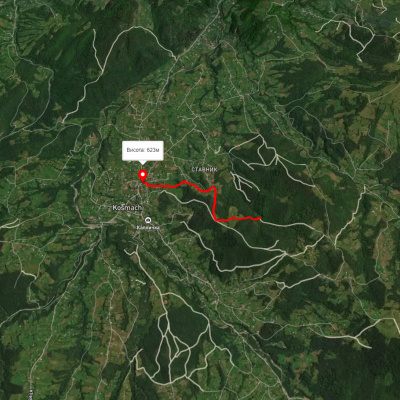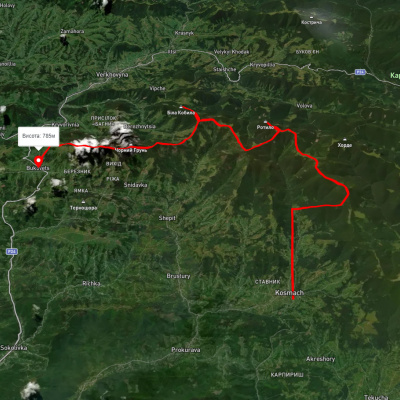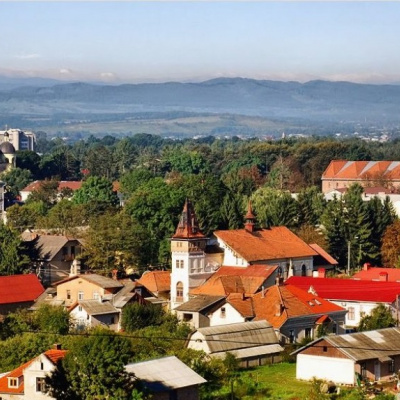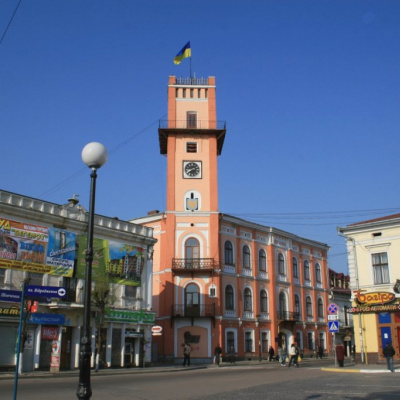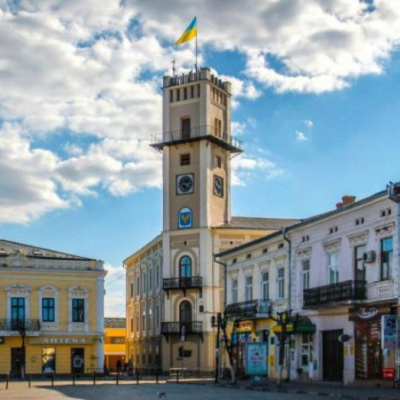Kolomyia
Kolomyia is one of the most interesting and cozy cities in western Ukraine in the Ivano-Frankivsk region. It is the center of Kolomyia district, the administrative center of Kolomyia District Council, a city of regional subordination, located on the Prut River in the southeastern part of the region, 65 km from Ivano-Frankivsk. A junction of railways and highways. Population - 61 thousand inhabitants (2019 data). It is a beautiful city with a very distinctive Austro-Hungarian character of the buildings. There are not just a lot of old townhouses from the turn of the nineteenth and twentieth centuries, there are a lot of them. Kolomyia has a large number of churches of various denominations (over 20). The most interesting landmark of the city is the Annunciation Church, also called the Savior's Church. It was built in 1587 and is considered the oldest wooden church in Galicia.
But no matter how many interesting old buildings Kolomyia has, its hallmark is still the giant egg that the Pysanka Museum is disguised as. The museum's collection includes more than six thousand exhibits. And here's another interesting piece of news for you: there is a long-standing Kolomyia tradition that the first persons of the state always come to the museum and sign eggs when they visit the city.

Kolomyia has been known since the mid-13th century as a salt mining center; it suffered significant damage during Turkish-Tatar attacks in the 16th and 17th centuries. In the 2nd half of the 17th and early 18th centuries, opryshky units operated in the vicinity of the city. Since the mid-nineteenth century, the city has experienced a rise in cultural and national development. During the First World War, it was in the war zone. Since 1939, it has been a part of the Ukrainian SSR; the district center since 1940. Since 1991 - in independent Ukraine; a significant economic, educational and cultural center of Pokuttya and the west of the state.
Distance to other cities: Ivano-Frankivsk - 64 km, Lviv - 192 km, Chernivtsi - 79.0 km, Kyiv - 573 km, Polianytsia (Bukovel ) - 83 km, Budapest - 598 km.
Today, the most common versions of the origin of the city's name are assumptions based on legends and legends. In particular, these are the versions that originated from the combination of the noun "kolo" (wheel) and the verb "mije" (to wash, to wash), from the Serbo-Croatian word "kolomijja", and from the male name Kolomij.
There is also a version that Kolomyia was founded in honor of the Galician king and Hungarian queen Koloman (Kalman) (1209-1241) in 1214, first expressed in the nineteenth century. There is also a variant that the city was named after the Prut River. Once upon a time, the Prut was called "Myi," and thus the city was called "Kolo Myia," or the circle of the Prut.
Archaeologists have discovered traces of the presence of tribes of Trypillian culture dating back almost 6,000 years on the outskirts of the city. The study of material sources covering the history of Kolomyia confirms that the territory of the modern city began to be intensively settled in the VII century BC. The original inhabitants of Kolomyia were engaged in agriculture and cattle breeding, using iron tools. Since the first half of the first millennium A.D., the carriers of the Carpathian barrows culture, which were associated with the Slavic ethnogenesis, have been living on the modern territory of the city.
Important events in the life of Kolomyia were marked by the VI-VIII centuries, when the settlement of modern Kolomyia emerged, developed, and performed certain political, social, and economic functions on the southwestern border of the Kyivan central state. All of these prerequisites led to the creation and formation of Kolomyia as a commercial center of intermediary trade at the crossroads from Western to Eastern Europe. It is most likely that from the very beginning Kolomyia was a military settlement, near which people could settle, finding a safe haven behind its walls, as well as "oruzhnyky"-hired troops or vigilantes.
The first mention of Kolomyia dates back to the middle of the thirteenth century (1240) and is contained in the Halychyna-Volyn Chronicle. Kolomyia began as a fortress guarding the Poprutska defense line. According to historians, the Kolomyia fortress was burned down in 1259 at the insistence of the Mongol-Tatar governor Burundai. Subsequently, in the same thirteenth century, the fortified center of Kolomyia moved to the site where the Kolomyia Town Hall is now located.
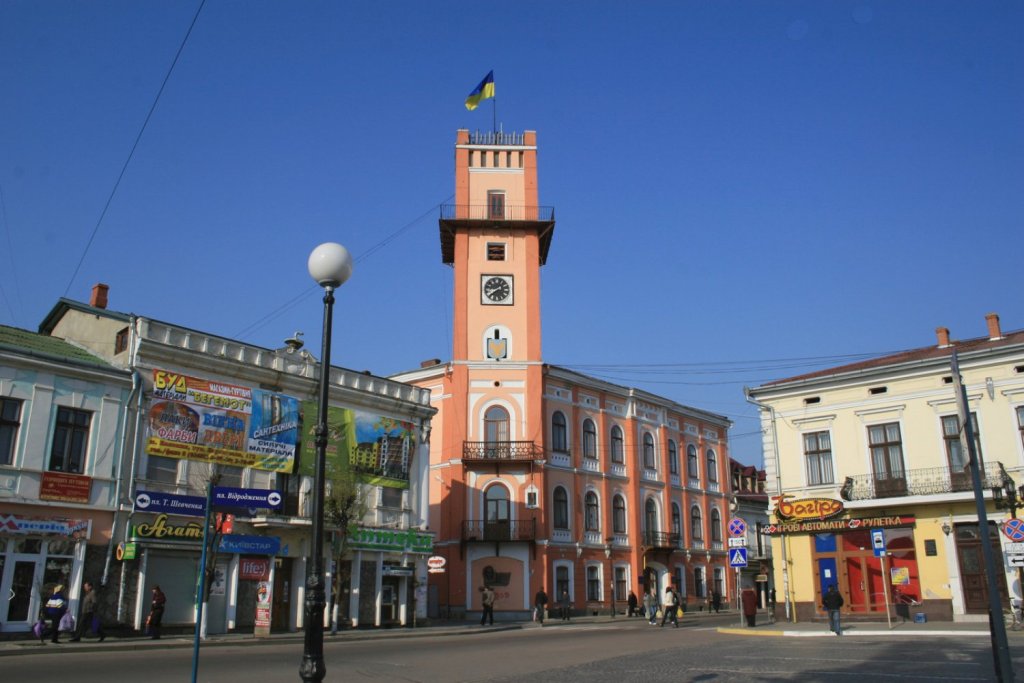
In 1405, the city received Magdeburg Law, which protected the rights of foreigners, but also granted certain privileges: the magistrate was given the right to open several of its own workshops and workshops, as well as to collect taxes from the surrounding villages for the city's needs. Trade revived in Kolomyia, with the so-called "Kolomyia people" actively selling salt mined in the region; crafts developed. At that time, the city was located on the border of Poland, Hungary, and Wallachia. In 1411, for 25 years and several times thereafter, for political reasons, Kolomyia Castle was ruled by Moldovan governors.
August 17-19, 1991. Kolomyia celebrated the 750th anniversary of its first chronicle mention. As part of the celebration, a monument to Stepan Bandera was unveiled on August 18. The crowded celebration with a rich program was the last event in the city during the Soviet era. The city's population welcomed the declaration of state independence in 1991. A significant majority of Kolomyia residents participated in all elections, especially actively supporting the Orange Revolution.
After the collapse of the USSR, Kolomyia's economy was in crisis for a long time. The system of management and ownership changed. Most of the enterprises that existed in the Soviet era fell into decline or liquidated themselves. A network of shopping and entertainment venues, cafes, restaurants, hotels, and travel agencies has grown.
After the declaration of independence, the pre-Soviet Ukrainian societies Prosvita and the Union of Ukrainian Women resumed their activities in Kolomyia; new organizations and societies emerged; and the one-party system became a thing of the past. With the revival of the Greek Catholic Church and freedom of religion in Kolomyia, a number of churches were restored in old buildings:
- TheChurch of St. Michael the Archangel of the UGCC (1990);
- Church of the Annunciation of the UOC (1991);
- Church of St. Josaphat (1991, originally the Church of the Assumption of the Blessed Virgin Mary);
- Roman Catholic Church of St. Ignatius of Loyola (1990);
- The Church of St. Nicholas of the UGCC (1996);
- Synagogue (1996).
New church buildings have been built or are still under construction:
- TheCathedral of theTransfiguration ofthe Lord of the UGCC (construction started in 1998);
- St. Nicholas Assumption Cathedral of the UOC (built in 1996);
- Cathedral of the Transfiguration of the Lord of the UOC-KP (begun construction in 1994);
- The Church of Evangelical Christians Baptists (built in 1998);
- Chapel of the Presentation of the Lord of the UGCC;
- Chapel of the Holy Apostles Peter and Paul;
- Church of the Intercession of the Mother of God;
- Church of St. Volodymyr and St. Olga, etc.
- Church of St. Michael the Archangel UGCC (1990);
- Church of the Annunciation of the UOC (1991);
- Church of St. Josaphat (1991, originally the Church of the Assumption of the Blessed Virgin Mary) - 93 Mazepa Street;
- Roman Catholic Church of St. Ignatius of Loyola (1990);
- Church of St. Nicholas of the UGCC (1996);
- Synagogue (1996).
- Museum of Easter egg painting - 43B Viacheslav Chornovil Avenue;
- City Hall - 1 Mykhailo Hrushevskoho Street;
- Museum of Folk Art of Hutsulshchyna and Pokuttya - 25 Teatralna Street;
- Annunciation (Savior) Church - 2 Karpatska Street;
- Cathedral ofthe Transfiguration of Christ (UGCC) - 31 Teatralna Street;
- Museum of the History of Kolomyia - 80 Roman Shukhevycha Street;
- Kolomyia Academic Regional Ukrainian Drama Theater named after Ivan Ozarkevych;
- Mykhailo Hrushevsky Gymnasium (Ursulianok Monastery ) - 19 Ivan Franko Street;
- Humor Center "Vesela Oselya " - 79B Hetman Ivan Mazepa Street;
- Ivan Franko Oak (natural monument)
- Dendrological Park.
The formation of Ukraine as a state within the city was not easy, but with great enthusiasm and enthusiasm. Numerous events were held - veches, actions, celebrations - that restored the historical truth that had been hidden or distorted during the Soviet era, and new festivals were launched: The International Hutsul Folklore and Ethnographic Festival, the International Festival of Children's Variety Art "Zorepad", the Regional Festival "Pysanka", the All-Ukrainian Theater Festival "Kolomyia Performances", the Festival "Honey Savior", the Festival-Fair of Local History Books "Kolomyia Manuscript", the Folklore Festival "Mountain Horns", the All-Ukrainian Theater Festival "Kolomyia Performances", etc.
Great changes have taken place in Kolomyia in recent years. A humanitarian gymnasium was reopened in the city, and after a 27-year break, a professional theater, the Kolomyia Academic Regional Ukrainian Drama Theater named after Ivan Ozarkevych, was reopened in 1990. The city returned the People's House.
The city has the Y. Kobrynskyi National Museum of Folk Art of Hutsulshchyna and Pokuttia, which is located in the former People's House, the Pysanka Museum, and the Kolomyia History Museum. In 2009, Kolomyia was named the"Safest City" in Ukraine by Focus magazine.
Cultural heritage monuments that are not subject to privatization:
- The 19th-century House of Culture at 7 Vichovyi Square;
- City Hall (1877) at 1 Hrushevskoho Street;
- The House of Public Organizations (1895), where the Sokil Society, known in Galicia, was located at 11 S. Petliura str. S. Petliury str. 11;
- The Church of St. Michael the Archangel and the bell tower (1855-1871) at 11 Hrushevskoho Street;
- The building of the former bank from the early 20th century at 1 Drahomanova Street;
- Wooden Annunciation Church of 1587 on Karpatska Street, 2;
- Bell tower of the Annunciation Church of the XVI century at 2 Karpatska street;
- XIX century church on I. Mazepa street, 2;
- The building of the former gymnasium of 1875 on A. Mickiewicz street, 1;
- Museum building of 1887-1902, 25 Teatralna St;
- Former building of a savings bank, 1892 Teatralna str. 27;
- Residential building of the XIX century Teatralna str. 33;
- Residential building of the early XX century 48 Teatralna str;
- Residential building of the early XX century Teatralna street, 54;
- Residential building of the XIX century, 3, I. Franko str;
- Church of St. Ignatius of Loyola of the XX century, 18 I. Franko str;
- Ursulianok Monastery of the early twentiethcentury, 19 I. Franka str;
- Residential building of the early XX century V. Chornovola str. 1;
- Medical institution building early XX century V. Chornovola str. 32;
- Post Office building of the early XX century 47 V. Chornovola str;
- Nineteenth-century residential building 57 V. Chornovola str;
- County Council House early 20th century R. Shukhevycha str. 80.
Які туристичні (пішохідні) маршрути проходять через/біля Kolomyia?
Пропонуємо пройти такі туристичні (пішохідні) маршрути через/біля Kolomyia: Шешори - Росохата, Дорога опришків, с. Космач, через г. Ротило, г. Грегіт, г. Біла Кобила до с.Буковець, с. Микуличин, через г. Хорде, г. Ротило до с. Космач, пер. Німчич - Протяте Каміння, ур. Медвежий - г. Куратул

